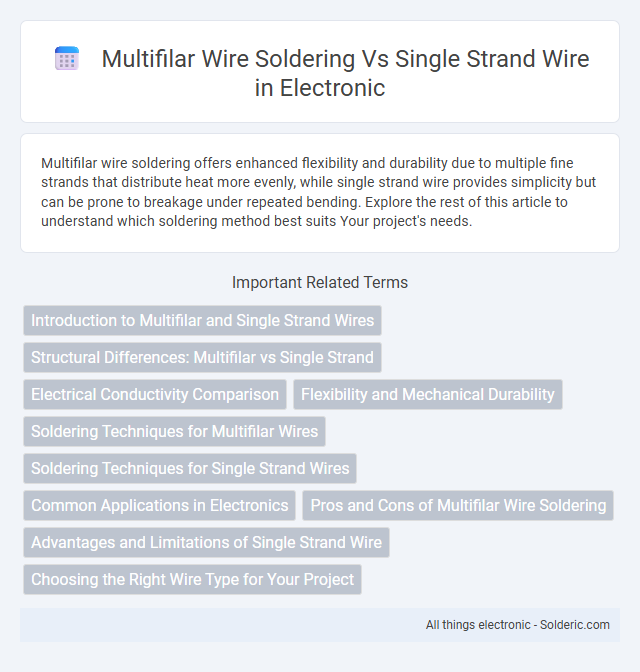Multifilar wire soldering offers enhanced flexibility and durability due to multiple fine strands that distribute heat more evenly, while single strand wire provides simplicity but can be prone to breakage under repeated bending. Explore the rest of this article to understand which soldering method best suits Your project's needs.
Comparison Table
| Feature | Multifilar Wire Soldering | Single Strand Wire |
|---|---|---|
| Conductivity | Higher flexibility enhances contact reliability | Consistent conductivity but less flexible |
| Flexibility | Excellent; multiple strands move independently | Low; rigid and prone to breakage under stress |
| Soldering Ease | More challenging; strands may separate | Simple; single solid core wire |
| Durability | Resistant to metal fatigue due to flexibility | Subject to cracking with repetitive bending |
| Use Cases | Ideal for flexible, high-movement applications | Suitable for fixed, low-movement setups |
| Cost | Generally higher due to manufacturing complexity | Lower cost, simpler manufacturing |
Introduction to Multifilar and Single Strand Wires
Multifilar wires consist of multiple thin strands twisted together, offering greater flexibility and improved conductivity compared to single strand wires, which are composed of a single solid conductor. Soldering multifilar wires requires careful twisting and tinning to ensure proper joint strength and electrical continuity, while single strand wires provide straightforward soldering with easier heat transfer and quicker bonds. Applications demanding durability and vibration resistance often favor multifilar wires, whereas single strand wires are preferred in rigid and static installations.
Structural Differences: Multifilar vs Single Strand
Multifilar wire consists of multiple thin strands twisted together, providing greater flexibility and durability compared to the single, solid conductor in single strand wire. This structural difference makes multifilar wire more resistant to bending fatigue and ideal for applications requiring repeated movement or vibration. Your choice of wire should consider these properties for improved mechanical performance and longer lifespan in soldered connections.
Electrical Conductivity Comparison
Multifilar wire, composed of multiple thin strands, offers improved flexibility and better conductivity due to increased surface area compared to single strand wire of the same gauge. Solder joints on multifilar wires tend to have lower resistance and enhanced current-carrying capacity, which optimizes electrical performance. When soldering, ensuring proper heat application preserves the conductivity benefits, making your connections more reliable and efficient.
Flexibility and Mechanical Durability
Multifilar wire soldering enhances flexibility by allowing individual strands to move independently, reducing stress concentrations compared to single strand wire. The multiple strands improve mechanical durability by distributing bending forces evenly, minimizing the risk of wire breakage under repetitive motion. Your projects benefit from increased resistance to fatigue and improved longevity when using multifilar wires in soldered connections.
Soldering Techniques for Multifilar Wires
Soldering techniques for multifilar wires require careful preparation to ensure each strand is evenly tinned before combining them into a solid joint, preventing cold solder joints and ensuring a reliable electrical connection. Using flux specifically designed for multifilar strands helps promote better solder flow and adhesion, while applying moderate heat avoids damaging the insulation on individual strands. Properly soldered multifilar wires enhance conductivity and mechanical strength, making them ideal for applications where flexibility and durability are critical to your wiring projects.
Soldering Techniques for Single Strand Wires
Soldering single strand wires requires precise heat control to prevent wire damage and ensure a strong electrical connection, focusing on clean, tinned wire ends before applying solder. Use a fine-tip soldering iron with rosin-core solder to avoid cold joints and optimize conductivity. Proper soldering techniques enhance durability in your electronic repairs and projects, minimizing resistance and potential connection failures.
Common Applications in Electronics
Multifilar wire soldering is preferred in electronics requiring flexibility and vibration resistance, such as wearable devices, robotics, and automotive wiring harnesses. Single strand wire is commonly used in static or low-movement applications like circuit boards and fixed electrical connections due to its ease of soldering and stability. The choice influences solder joint reliability and electrical performance in devices with varying mechanical stresses.
Pros and Cons of Multifilar Wire Soldering
Multifilar wire soldering offers improved flexibility and better electrical performance due to multiple fine strands providing a larger surface area for current flow compared to single strand wire. The main advantages include enhanced durability against bending stress and reduced risk of breakage, while the cons involve increased difficulty in soldering as fine strands can easily wick solder away and require careful tinning to ensure strong connections. Proper technique and sufficient heat application are essential to avoid cold joints and maintain reliable conductivity in multifilar wire soldering applications.
Advantages and Limitations of Single Strand Wire
Single strand wire offers superior mechanical strength and simplified soldering due to its solid core, making it ideal for applications requiring stable, low-resistance connections. However, its stiffness limits flexibility and makes it prone to metal fatigue when subjected to repeated bending, unlike multifilar wire which excels in flexible environments. You should choose single strand wire for permanent, stationary installations where durability and ease of soldering are prioritized over flexibility.
Choosing the Right Wire Type for Your Project
Multifilar wire soldering offers improved flexibility and durability compared to single strand wire, making it ideal for projects requiring frequent movement or vibration resistance. Single strand wire provides better conductivity and ease of soldering for static connections where rigidity is preferred. Assess your project's mechanical demands and electrical requirements to select the wire type that ensures optimal performance and longevity.
multifilar wire soldering vs single strand wire Infographic

 solderic.com
solderic.com